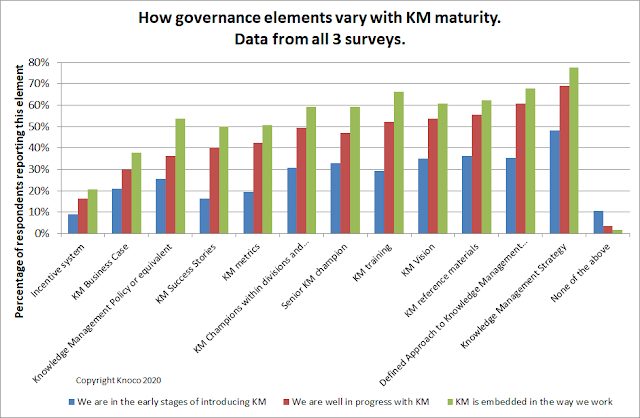Which are the most commonly-used elements of KM governance?
As part of our three global surveys of Knowledge Management professionals in 2014, 2017 and 2020, we asked the participants to select from a list the Knowledge Management governance elements that had in place in their organisation.
Most of the survey respondents reported at least one element of Knowledge Management governance, with the most common being the Knowledge Management Strategy (reported by 62% of the people who responded to this question).
Having a defined KM approach was second highest, followed by KM reference materials, to allow this approach to be followed.
It is also interesting to see a Knowledge Management policy being applied in 35% of the cases. KM policies are quite hard to find online – but there must be a few of them out there.
Please do not think that because a governance element is low in the list, that it is not important!
We would suggest that all these elements are important, with the exception of having a separate KM incentive system (see here for more on KM incentives). It’s just that some are more commonly applied than others, often because people do not realise the value these elements bring.
The diagram below shows how the usage of these KM governance elements varies as the KM program matures from the early stages (blue), through “well in progress” (red) to fully embedded (green).

Firstly it is seems that the big difference – the biggest jump – is between the early stagers and those who are well in progress. This represents either the adoption of KM governance needed for progression, or the lack of progress of those who do not have those elements.
Those organisations where KM is embedded have an even greater application of all of the KM governance elements, the top 4 being KM strategy, Knowledge Management framework, KM training and KM reference materials. The biggest proportional difference in usage is the KM success stories, which tend to be collected as the KM initiative progresses.
At Knoco we would suggest that some of these governance elements should be developed within the first year of your KM journey, notably the strategy, the framework, the business case, the vision and the high level champion. Others such as the success stories and the network of champions in the business should be the next target, while the KM policy, training, metrics and reference are late-stage governance items.
Tags: Archive, governance, survey


Leave a Reply